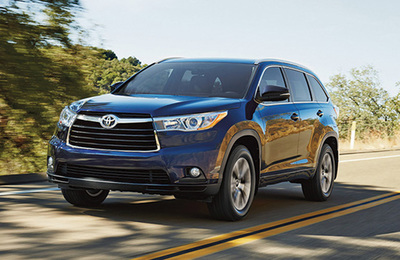2016 Toyota Highlander Review by Steve Purdy +VIDEO
2016 TOYOTA HIGHLANDER
Review by Steve Purdy
The Auto Channel
Michigan Bureau
For those who continue to complain that all vehicles look alike these days I say, that’s not always the case. Just look at cars like the Nissan Murano, Lexus NX and many Mercedes Benz cars. On the other hand they are quite right when talking about the mainstream, three-row crossovers like the Dodge Durango, Nissan Pathfinder, the Korean entries and this Toyota Highlander.
Don’t get me wrong, the Highlander is a fine crossover - competent, comfortable and nicely designed, but it does not stand out much aesthetically from the equally competent crowd. They’re all pretty good looking but they mostly look alike.
The front-wheel drive, all-wheel drive optional, uni-body Highlander weighs in at around 5,800 pounds and will accommodate either 7 or 8 passengers depending on the second row seating configuration you choose. It comes in four trim levels – LE, LE Plus, XLE and Limited. The LE with four-cylinder engine starts at just $30,490. Our well-equipped XLE All-Wheel Drive starts at $39,275. (See Links To Complete Specs For All Highlander Trim Models Below Review)
A Highlander Hybrid (27/28 mpg) is also available and only comes with high-end content starting at $47,870.
Distinguishing one of these crossovers from another is primarily the grille and front fascia. The Highlander shares the newer Toyota styling language that uses a massive, gaping grille with big emblem in the center. The Highlander’s modest sculpting and sharply protruding, high-mounted taillights give it just a whisp more personality than some of the others.
Highlander’s interior, as we would expect from such a utilitarian vehicle, has lots of handy, thoughtful features led by a horizontal shelf lining the lower dash from the driver’s instrument cluster all the way to the passenger’s door. Intermittent ridges keep things from sliding across. Eight cup holders, four bottle holders, extra large, roll-top console, well-placed controls, a good sized multi-function screen and attractive design make this a convenient place to spend time. Ergonomics, including placement of USB and auxiliary ports are good.
On the downside, I’m not fond of the navigation system including the map. The voice activation function couldn’t understand me after repeated attempts with increasingly crisp elocution – and I host a radio show, so I think I’m pretty good. It immediately responded to my pretty wife’s voice though. What’s up with that? I also found the map harder to read than most and struggled to manage the half-screen/full-screen modes. Like all these systems, if we live with them for a while we get proficient but I found this one a challenge.
Seating at all positions are good, even in the way back. We don’t expect full size people to be comfortable back there but if they’re not too big they will be. And, access is good with second row seats that fold well out of the way. With the captain’s seats for the second row like our tester, we have plenty of room between the seats to slide into the rear as well.
Cargo capacity is not much different than the others with 83.7 cubic-feet and a flat surface with second and third row seatbacks folded, 42.3 cubic-feet with just the third row folded and 13.8 cubic feet with all seatbacks in position. Some continue to call this kind of vehicle a “sport-utility.” I would hesitate to call it sporty, but we can certainly consider it utilitarian.
Our test car’s 3.5-liter V-6 makes a good 270 horsepower and 248 pound-feet of torque and is mated to a well-calibrated six-speed automatic transmission. We have plenty of power. The EPA estimates we’ll get around 18 mpg in the city and 24 on the highway on regular fuel (one click better on each end without AWD) and our experience was well within that range. The 4-cylinder is good for only 1,500 pounds of towing and while we have not driven one we could expect tepid performance.
With the V-6 engine you also automatically get the towing package that will allow for 5,000 pounds of capacity. If you need to tow more than that you’ll need to go with a truck-based vehicle like Sequoia or Tahoe. The 4-cylinder Highlander is good for only 1,500 pounds of towing.
The Toyota new vehicle warranty covers the whole car for 3 years or 36,000 miles and the powertrain for 5 years or 60,000 miles.
The traditional Toyota quality partly accounts for the CUV’s good residual value and cost of ownership is claimed to be best-in-class.
As alluded to earlier in this narrative, we put many highway miles on our Highlander this week. We found its driving dynamics and road manners excellent and its cabin a most pleasant place to spend time. Road noise could not find its way inside and we found nothing in its ergonomics about which we could complain. The Toyota designers have always been skilled at providing handy and convenient features and this CUV is no exception.
So, if you need something this big you have plenty of choices in our rich marketplace. Just be sure the Highlander is on your shopping list.
©Steve Purdy, Shunpiker Productions, All Rights Reserved
More Independent Toyota Buyer's Research Data Than Anywhere Else On The Web
- Toyota Buyers Guide | Specs, Prices, Expert Reviews and Comparisons 2017-1997
- Find Your Perfect New Car Match
- The Auto Channel's Toyota Brand Archives; News, Press Releases, Reviews, Specifications, Prices, Video, Images (56,546 Annotations)



